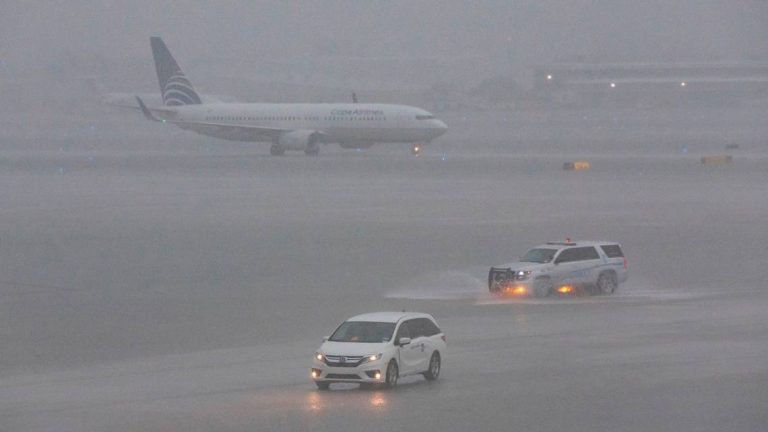Miami Weather 2024: Closures, Flight impacts, Flood Risks And Everything To Know

Miami, Florida, known for its vibrant culture, beautiful beaches, and tropical climate, experienced a mix of scorching heat and refreshing rain in 2024.
Rain and Flooding
- Emergency Declaration: Multiple communities across South Florida, including Miami and Fort Lauderdale, grappled with life-threatening flooding due to torrential rain. Florida Governor Ron DeSantis also declared an emergency for several counties, emphasizing the impact on critical infrastructure.
- Also Stranded Drivers: Water levels rose, submerging cars and parking decks. Some residents spent hours stuck in their vehicles due to flooded streets and stalled traffic lights.
- Repeat Incidents: This wasn’t an isolated event. The Miami area also faced flooding issues for two consecutive days, with storms dropping 2 to 5 inches of rain on Tuesday and Wednesday.
Flight Disruptions
- Airport Chaos: Over 600 flights were canceled or delayed at Miami International Airport and Fort Lauderdale-Hollywood International Airport. Thunderstorms and heavy rain disrupted air travel, also affecting travelers across the region.
Tornado Touchdown
- EF1 Tornado: Hobe Sound, located north of West Palm Beach, experienced an EF1 tornado during the storm system. The National Weather Service confirmed the tornado’s impact.
Hottest Days:
- 96 °F: The mercury soared to this temperature three times in 2024, also most recently on May 26. Miami residents sought shade and icy drinks to beat the heat.
- Other scorchers also included May 19 and May 15, both hitting 96 °F.
Coldest Moments:
- 52 °F: The chilliest days saw Miami residents reaching for light jackets. January 21 and also January 1 both recorded this low temperature.
- Breezy mornings and cooler evenings prevailed during these moments.
Precipitation:
- 18.1 inches: Miami received a total of 18.1 inches of precipitation throughout the year.
- The wettest day was March 22, with a whopping 2.3 inches of rain. Umbrellas were also a must!
- Surprisingly, there was no snowfall in Miami during 2024.

Monthly Highlights:
January 2024:
- Average High: 73 °F
- Average Low: 57 °F
- Also Precipitation: A dry start to the year, with no significant rainfall recorded.
February 2024:
- Average High: 74 °F
- Average Low: 57 °F
- Rainfall Highlight: February 18 brought 1.88 inches of rain, making it the wettest day of the month.
March 2024:
- Average High: 77 °F
- Average Low: 61 °F
- Notable Event: On March 22, Miami experienced a downpour, receiving 2.3 inches of rain in a single day.
April 2024:
- Average High: 80 °F
- Average Low: 65 °F
- Spring Vibes: April saw pleasant temperatures, perfect for beach outings and outdoor activities.
May 2024:
- Average High: 84 °F
- Average Low: 70 °F
- Heat Waves: May 26 reached a scorching 96 °F, also reminding everyone to stay hydrated.
June 2024:
- Average High: 87 °F
- Average Low: 74 °F
- Also Summer Arrives: June marked the official start of summer, with warm evenings and balmy nights.
July 2024:
- Average High: 89 °F
- Average Low: 76 °F
- Sunshine and Humidity: July brought plenty of sun and also occasional afternoon showers.
Also August 2024:
- Average High: 90 °F
- Average Low: 77 °F
- Tropical Storm Alert: August 28 saw increased rainfall due to a tropical storm passing nearby.
September 2024:
- Average High: 88 °F
- Also Average Low: 75 °F
- Post-Storm Recovery: Miami recovered from the storm, with pleasant temperatures.
AlsoOctober 2024:
- Average High: 84 °F
- Average Low: 70 °F
- Fall Breezes: October evenings cooled down, also signaling the arrival of fall.
November 2024:
- Average High: 79 °F
- Also Average Low: 64 °F
- Thanksgiving Weather: November provided comfortable weather for holiday gatherings.
December 2024:
- Average High: 75 °F
- Average Low: 60 °F
- Festive Season: Miami residents enjoyed mild temperatures during the holiday season.
South Florida’s 2024 weather events left a lasting impact on transportation, infrastructure, and also communities. As we reflect on this challenging time, let’s remember the resilience of those affected.

